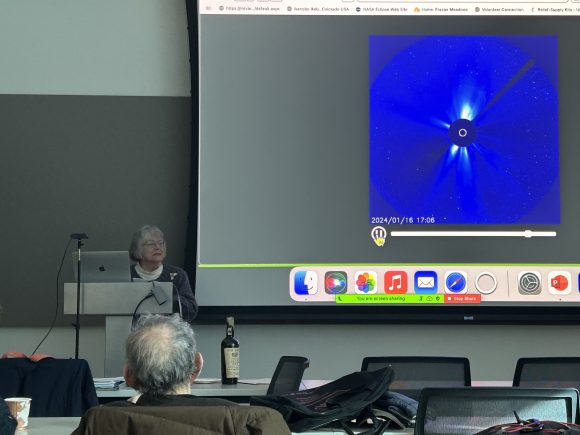
Jo Ann Joselyn speaks about her research of coronal mass ejections in the CASE building on Tuesday, Jan. 16. (Ann Marie Vanderveen/CU Independent).
The University of Colorado Boulder Retired Faculty Association hosted Jo Ann Joselyn, a 2002 Colorado Women’s Hall of Fame inductee for her career in the space sciences. Her talk on Jan. 16 focused on her research of sun activity and her career as a woman of many firsts.
Joselyn graduated with a PhD in astro-geophysics at CU Boulder in 1978, becoming the first woman to earn a doctoral degree in that department.
“The space age had completely revolutionized the scientific discipline of space science, and my major turned out to be plasma physics, a topic that had not existed when I was getting my master’s degree a few years before,” Joselyn said, referring to the rapid advancement in space exploration and research in the 1970s.
Joselyn’s graduation from CU Boulder led her to a career working for the National Oceanic and Atmospheric Administration’s Space Weather Prediction Center. She researched coronal mass ejections (CME), the discharge of material from the outer atmosphere of the sun. CMEs directed toward Earth can disrupt power grids as they interfere with the magnetic field.
“One of the takeaways, obviously, is that the sun controls many things in our environment, not just weather… but also controls things like the safety of electronic equipment,” said Jeffery Linsky, an audience member and professor emeritus in the astrophysical and planetary sciences department.
Joselyn’s career led her to serve as the first woman and first American secretary general of the International Union of Geodesy and Geophysics, a global non-governmental organization involved in the advancement of scientific exploration into Earth and space. She also served as the first female secretary general of the International Association of Geomagnetism and Aeronomy, an association of the IUGG.
When asked how careers in science have become more accessible to women, Joselyn replied. “I think (women) basically just got permission… It just suddenly became okay to do that. Once it’s okay, then the women picked it up.”
In the 2023 CU Boulder Fall Enrollment Census, women made up 52.8% of those enrolled in the astrophysical and planetary studies major. This is up from 29.4% in 2013 and marks the highest female enrollment for this major in last decade of records available.
Joselyn’s work in improving the accuracy of CME predictions will be especially important this year as 2024 marks the peak of the sun’s 11-year cycle. Solar activity is expected to be at its highest between January and October. The Space Weather Prediction Center will update its website for any space weather alerts, a page Joselyn said she visits daily despite her retirement from the institution.
Joselyn’s long career has spanned many cultural changes in the scientific field as well as helped instigate some of them. Linsky recalled attending the most recent American Astronomical Society meeting and noticing that a significant portion of the younger attendees were women.
“This large wave of female astronomers is not just at the undergraduate/graduate level where it’s totally obvious. It’s gone into the junior faculty and now in the more senior faculty,” said Linsky. “Things have changed and it’s ocurring very rapidly.”
Contact CU Independent Breaking News Editor Ann Marie Vanderveen at ann.vanderveen@colorado.edu.
